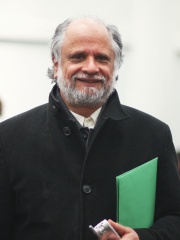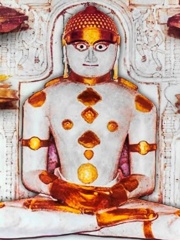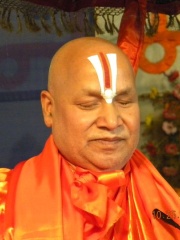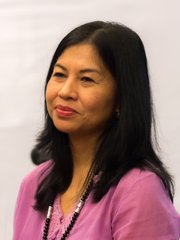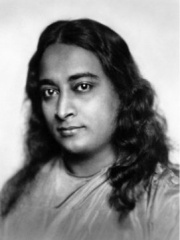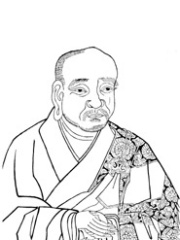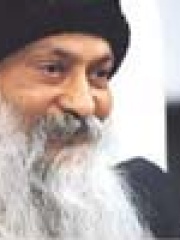
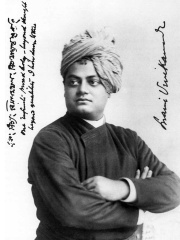
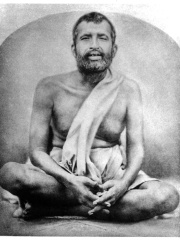
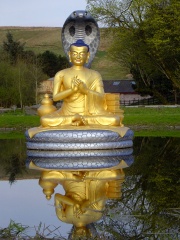
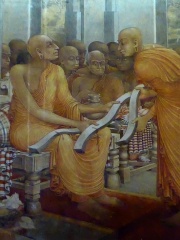
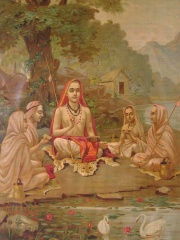
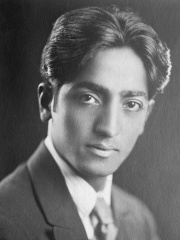
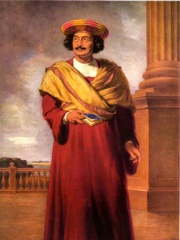
The Most Famous
PHILOSOPHERS from India
This page contains a list of the greatest Indian Philosophers. The pantheon dataset contains 1,267 Philosophers, 48 of which were born in India. This makes India the birth place of the 8th most number of Philosophers behind Greece, and Türkiye.
Top 10
The following people are considered by Pantheon to be the top 10 most legendary Indian Philosophers of all time. This list of famous Indian Philosophers is sorted by HPI (Historical Popularity Index), a metric that aggregates information on a biography's online popularity. Visit the rankings page to view the entire list of Indian Philosophers.

1. Rajneesh (1931 - 1990)
With an HPI of 83.75, Rajneesh is the most famous Indian Philosopher. His biography has been translated into 68 different languages on wikipedia.
Rajneesh (born Chandra Mohan Jain; 11 December 1931 – 19 January 1990), also known as Acharya Rajneesh, and commonly known as Osho (Hindi: [ˈoːʃoː]), was an Indian godman, philosopher, mystic, and founder of the Rajneesh movement. He was a controversial new religious movement leader during his life. He rejected institutional religions, insisting that spiritual experience could not be organized into any one system of religious dogma. As a guru, he advocated meditation and taught a unique form called dynamic meditation. Rejecting traditional ascetic practices, he encouraged his followers to embrace life fully while remaining unattached to worldly desires. Rajneesh experienced a spiritual awakening in 1953 at the age of 21. Following several years in academia, in 1966 Rajneesh resigned his post at the University of Jabalpur as a lecturer in philosophy, and began traveling throughout India, becoming known for his criticism of the orthodoxy of mainstream religions, as well as of mainstream political ideologies and of Mahatma Gandhi. In 1970, Rajneesh spent time in Mumbai initiating followers referred to as "neo-sannyasins". During this period, he expanded his spiritual teachings and commented extensively in discourses on the writings of religious traditions, mystics, bhakti poets, and philosophers from around the world. In 1974, Rajneesh relocated to Pune, where an ashram was established and a variety of therapies, incorporating methods first developed by the Human Potential Movement, were offered to a growing Western following. By the late 1970s, the tension between the ruling Janata Party government of Morarji Desai and the movement led to a curbing of the ashram's development and a back tax claim estimated at $5 million. In 1981, the Rajneesh movement shifted its focus to the United States, where Rajneesh established a commune called Rajneeshpuram in Wasco County, Oregon. The movement ran into conflict with county residents and the state government, and a succession of legal battles concerning the ashram's construction and continued development curtailed its success. In 1985, Rajneesh publicly asked local authorities to investigate his personal secretary Ma Anand Sheela and her close supporters for a number of crimes, including a 1984 mass food-poisoning attack intended to influence county elections, an aborted assassination plot on U.S. attorney Charles H. Turner, the attempted murder of Rajneesh's personal physician, and the bugging of his own living quarters; authorities later convicted several members of the ashram, including Sheela. That year, Rajneesh was deported from the United States on separate immigration-related charges in accordance with an Alford plea. After his deportation, 21 countries denied him entry. Rajneesh returned to Mumbai in 1986 and, after a period of public discourse, moved back to Pune in January 1987 to revive his ashram, where he died in 1990. Rajneesh's ashram, now known as OSHO International Meditation Resort, and all associated intellectual property, is managed by the registered Osho International Foundation (formerly Rajneesh International Foundation). Rajneesh's teachings have had an impact on Western New Age thought, and their popularity increased after his death.

2. Swami Vivekananda (1863 - 1902)
With an HPI of 82.73, Swami Vivekananda is the 2nd most famous Indian Philosopher. His biography has been translated into 92 different languages.
Swami Vivekananda () (12 January 1863 – 4 July 1902), born Narendranath Datta, was an Indian Hindu monk, philosopher, author, religious teacher, and the chief disciple of the Indian mystic Ramakrishna. Vivekananda was a major figure in the introduction of Vedanta and Yoga to the Western world, and is credited with raising interfaith awareness and elevating Hinduism to the status of a major world religion. Vivekananda showed an early inclination towards religion and spirituality. At the age of 18, he met Ramakrishna and became his devoted disciple, and later took up the vows of a sannyasin (renunciate). Following Ramakrishna’s death, Vivekananda travelled extensively across the Indian subcontinent as a wandering monk, gaining first-hand knowledge of the often harsh living conditions endured by the Indian masses under then British India, he sought a way to alleviate their suffering by establishing social services but lacked capital. In 1893, he travelled to the United States to participate in the Parliament of the World's Religions in Chicago, where he delivered a landmark speech beginning with the words "Sisters and brothers of America...". His powerful message introduced Hindu spiritual thought and advocated for both religious tolerance and universal acceptance. The speech made a profound impression; an American newspaper described him as "an orator by divine right and undoubtedly the greatest figure at the Parliament". Following his success in Chicago, Vivekananda lectured widely across the United States, the United Kingdom, and continental Europe, disseminating the essential principles of Hindu philosophy. He established the Vedanta Society of New York and the Vedanta Society of San Francisco (now the Vedanta Society of Northern California), both of which became the foundations for later Vedanta Societies in the West. In India, he founded the Ramakrishna Math, a monastic order for spiritual training, and the Ramakrishna Mission, dedicated to social services, education, and humanitarian work. Vivekananda is widely regarded as one of the greatest modern Indian thinkers. He was a prominent philosopher, social reformer, and the most successful proponent of Vedanta philosophy abroad. He played a crucial role in the Hindu revivalist movement and contributed significantly to the rise and development of Indian nationalism in colonial India. Celebrated as a patriotic saint, his birth anniversary is observed in India as National Youth Day.

3. Ramakrishna (1836 - 1886)
With an HPI of 81.84, Ramakrishna is the 3rd most famous Indian Philosopher. His biography has been translated into 82 different languages.
Ramakrishna (18 February 1836 – 16 August 1886), also called Ramakrishna Paramahamsa (Bengali: রামকৃষ্ণ পরমহংস, romanized: Ramôkṛṣṇo Pôromohôṅso; pronounced [ramɔkriʂno pɔromoɦɔŋʃo] ; IAST: Rāmakṛṣṇa Paramahaṃsa), born Ramakrishna Chattopadhyay (his childhood nickname was Gadadhar), was an Indian Hindu mystic. He was a devotee of the goddess Kali, but adhered to various religious practices from the Hindu traditions of Vaishnavism, Tantric Shaktism, and Advaita Vedanta, as well as Christianity and Sufi Islam. His parable-based teachings advocated the essential unity of religions and proclaimed that world religions are "so many paths to reach one and the same goal". He is regarded by his followers as an avatar (divine incarnation). Ramakrishna was born in Kamarpukur, Bengal Presidency, India. He described going through religious experiences in childhood. Around the age twenty, he became a temple priest at the Dakshineshwar Kali Temple in Calcutta. While at the temple, his devotional temperament and intense religious practices led him to experience various spiritual visions. He was assured of the authenticity and sanctity of his visions by several religious teachers. Ramakrishna's native language was Bengali, but he also spoke Hindi (Hindustani) and understood Sanskrit. There are instances recorded in the Gospel of Ramakrishna of him using English words a few times. In 1859, in accordance with then prevailing customs, Ramakrishna was married to Sarada Devi, a marriage that was never consummated. As described in the Gospel of Ramakrishna, he took spiritual instruction from several gurus in various paths and religions, and was also initiated into sannyasa in 1865 by Tota Puri, a vedanta monk. Ramakrishna gained widespread acclaim amongst the temple visiting public as a guru, attracting social leaders, elites, and common people alike. Although initially reluctant to consider himself a guru, he eventually taught disciples and founded the monastic Ramakrishna Order. His emphasis on direct spiritual experience instead of adhering to scriptural injunctions has been influential. Ramakrishna died due to throat cancer on the night of 15 August 1886. After his death, his chief disciple Swami Vivekananda continued and expanded his spiritual mission, both in India and the West.

4. Nagarjuna (150 - 250)
With an HPI of 80.71, Nagarjuna is the 4th most famous Indian Philosopher. His biography has been translated into 105 different languages.
Nāgārjuna (Sanskrit: नागार्जुन, Nāgārjuna; c. 150 – c. 250 CE) was an Indian philosopher and Mahāyāna Buddhist monk of the Madhyamaka (Centrism, Middle Way) school. Nāgārjuna is widely considered one of the most important Buddhist philosophers. He was the founder of the Madhyamaka school of Buddhist philosophy and a defender of the Mahāyāna movement. His Mūlamadhyamakakārikā (Root Verses on Madhyamaka, MMK) is the most important text on the Madhyamaka philosophy of emptiness. The MMK inspired a large number of commentaries in Sanskrit, Chinese, Tibetan, Korean and Japanese and continues to be studied today.
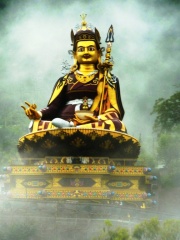
5. Padmasambhava (717 - 762)
With an HPI of 78.07, Padmasambhava is the 5th most famous Indian Philosopher. His biography has been translated into 54 different languages.
Padmasambhava ('Born from a Lotus'), also known as Guru Rinpoche ('Precious Guru'), was a semi-legendary tantric Buddhist Vajra master from medieval India, who according to hagiographical sources fully revealed the Vajrayana in Tibet, circa 8th – 9th centuries. He is considered an emanation or Nirmāṇakāya of Shakyamuni Buddha as foretold by the Buddha himself. According to early Tibetan sources including the Testament of Ba, he came to Tibet in the 8th century and designed Samye Monastery, the first Buddhist monastery in Tibet during the reign of King Trisong Detsen. He, the king, and Khenpo Shantarakshita are also responsible for creating the Tibetan Canon through translating all of the Buddha's teachings and their commentaries into the Tibetan language. According to Lewis Doney, while his historical authenticity was questioned by earlier Tibetologists, it is now "cautiously accepted.” Padmasambhava himself was recorded as saying he was a historical person, and his footprints left in rocks are evidence. Padmasambhava later came to be viewed as a central figure in the transmission of Buddhism to Tibet. Starting from around the 12th century, hagiographies concerning Padmasambhava were written. These works expanded the profile and activities of Padmasambhava, now seen as taming all the Tibetan spirits and gods, and concealing various secret texts (terma) for future tertöns. Nyangral Nyima Özer (1124–1192) was the author of the Zangling-ma (Jeweled Rosary), the earliest biography of Padmasambhava. He has been called "one of the main architects of the Padmasambhava mythos – who first linked Padmasambhava to the Great Perfection in a high-profile manner." In modern Tibetan Buddhism, Padmasambhava is considered to be a Buddha that was foretold by Buddha Shakyamuni. According to traditional hagiographies, his students include the great female masters Yeshe Tsogyal and Mandarava. The contemporary Nyingma school considers Padmasambhava to be a founding figure. The Nyingma school also traditionally holds that its Dzogchen lineage has its origins in Garab Dorje through a lineage of transmission to Padmasambhava. In Tibetan Buddhism, the teachings of Padmasambava are said to include an oral lineage (kama), and a lineage of the hidden treasure texts (termas). Tibetan Buddhism holds that Padmasambhava's termas are discovered by fortunate beings and tertöns (treasure finders) when conditions are ripe for their reception. Padmasambhava is said to appear to tertöns in visionary encounters, and his form is visualized during guru yoga practice, particularly in the Nyingma school. Padmasambhava is widely venerated by Buddhists in Tibet, Nepal, Bhutan, the Himalayan states of India, and in countries around the world.

6. Buddhaghosa (401 - 500)
With an HPI of 76.08, Buddhaghosa is the 6th most famous Indian Philosopher. His biography has been translated into 37 different languages.
Buddhaghosa was a 5th-century Sinhalese Theravādin Buddhist commentator, translator, and philosopher. He worked in the great monastery (mahāvihāra) at Anurādhapura, Sri Lanka and saw himself as being part of the Vibhajyavāda school and in the lineage of the Sinhalese mahāvihāra. His best-known work is the Visuddhimagga ("Path of Purification"), a comprehensive summary of older Sinhala commentaries on the scriptural canon of the Theravāda school. According to Sarah Shaw, in Theravāda Buddhism this systematic work is "the principal text on the subject of meditation." The interpretations provided by Buddhaghosa have generally constituted the orthodox understanding of Theravādin scriptures since at least the 12th century CE. Buddhaghosa is generally recognized by both Western scholars and Theravādin Buddhists as the most important philosopher and commentator of the Theravāda school.

7. Adi Shankara (788 - 820)
With an HPI of 75.37, Adi Shankara is the 7th most famous Indian Philosopher. His biography has been translated into 79 different languages.
Adi Shankara (8th c. CE), also called Adi Shankaracharya (Sanskrit: आदि शङ्कर, आदि शङ्कराचार्य, romanized: Ādi Śaṅkara, Ādi Śaṅkarācārya, lit. 'First Shankaracharya', pronounced [aːd̪i ɕɐŋkɐraːt͡ɕaːrjɐ]), was an Indian Vedic scholar-monk, philosopher, and teacher (acharya) of Advaita Vedanta, who has popular become known as a Saivite "divine folk-hero who spread his teaching through his digvijaya ("universal conquest,") all over India like a victorious conqueror," due to 14th century political and religious developments in the Vijayanagara Empire and hagiographies dating from the 14th-17th centuries. While in recent times he is often revered as the most important Indian philosopher, reliable information on Shankara's actual life is scant, and the historical influence of his works on Hindu intellectual thought has been questioned. The historical Shankara was probably relatively unknown and Vaishna-oriented. His true impact lies in his "iconic representation of Hindu religion and culture," despite the fact that most Hindus do not adhere to Advaita Vedanta. Owing to his later fame over 300 texts are attributed to him, including commentaries (Bhāṣya), introductory topical expositions (Prakaraṇa grantha) and poetry (Stotra). However, most of these are likely to have been written by admirers, or pretenders, or scholars with an eponymous name. Works known to have been written by Shankara himself are the Brahmasutrabhasya, his commentaries on ten principal Upanishads, his commentary on the Bhagavad Gita, and the Upadeśasāhasrī. The authenticity of Shankara as the author of Vivekacūḍāmaṇi has been questioned and mostly rejected by scholarship. His authentic works present a harmonizing reading of the shastras, with liberating knowledge of the self at its core, synthesizing the inherited Advaita Vedanta teachings of his time. The central concern of Shankara's writings was the liberating knowledge of the true identity of jivatman (individual self) as Ātman-Brahman, taking the Upanishads as the authoritative means of knowledge, beyond the ritually oriented Mīmāṃsā-exegesis of the Vedas. Shankara's Advaita showed influences from Mahayana Buddhism, despite Shankara's critiques; and Hindu Vaishnava opponents have even accused Shankara of being a "crypto-Buddhist," a qualification which is rejected by the Advaita Vedanta tradition, highlighting their respective views on Atman, Anatta and Brahman.

8. Jiddu Krishnamurti (1895 - 1986)
With an HPI of 75.31, Jiddu Krishnamurti is the 8th most famous Indian Philosopher. His biography has been translated into 78 different languages.
Jiddu Krishnamurti ( JID-oo KRISH-nə-MOOR-tee; 11 May 1895 – 17 February 1986) was an Indian spiritual figure, speaker, and writer. Adopted by members of the Theosophical Society as a child, Krishnamurti was raised to fill the mantle of the prophesied World Teacher, a role tasked with aiding humankind's spiritual evolution. In 1922, he began to suffer from painful, seizure-like mystical episodes that would produce a lasting change in his perception of reality. In 1929, he broke from the Theosophy movement and disbanded the Order of the Star in the East which had been formed around him. He spent the rest of his life speaking to groups and individuals around the world, hoping to contribute a radical transformation of mankind. Krishnamurti asserted that "truth is a pathless land" and advised against following any doctrine, discipline, teacher, guru, or authority, including himself. Nonetheless, during his life he tried to share his insights in 'the teachings', urging for a state without conceptual deliberations and thought. In Krishnamurti's perception, such a righteousness was only possible through the practice of passive or choiceless awareness, which he called the essence of "true meditation" in contrast to contrived techniques. He gained a wider recognition in the 1950s, after Aldous Huxley had introduced him to his mainstream publisher and the publication of The First and Last Freedom (1954). Many of his talks have been published since, among them Commentaries on Living (1956–60) and Krishnamurti's Notebook (written 1961-62). A few days before his death he stated that nobody had understood what his body went through, and after his death, this consciousness would be gone, and no other body would support it "for many hundred years." His supporters — working through non-profit foundations in India, Britain, and the United States — oversee several independent schools based on his educational philosophy and continue to distribute his extensive body of talks, dialogues, and writings in various media formats and languages.

9. Ram Mohan Roy (1772 - 1833)
With an HPI of 75.03, Ram Mohan Roy is the 9th most famous Indian Philosopher. His biography has been translated into 53 different languages.
Raja Ram Mohan Roy (22 May 1772 – 27 September 1833) was an Indian reformer and writer who was one of the founders of the Brahmo Sabha in 1828, the precursor of the Brahmo Samaj, a socio-religious reform movement in the Indian subcontinent. He has been dubbed the "Father of Indian Renaissance." He was given the title of Raja by Mughal emperor Akbar II (r. 1806–1837). His influence was apparent in the fields of politics, public administration, education and religion. He was known for his efforts to abolish the practices of sati and child marriage. Roy wrote Gaudiya Vyakaran which was the first complete Bangla grammar written book.
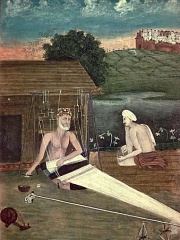
10. Kabir (1440 - 1518)
With an HPI of 74.51, Kabir is the 10th most famous Indian Philosopher. His biography has been translated into 65 different languages.
Kabir (fl. 15th century) was a well-known Indian devotional mystic poet and sant. His writings influenced Hinduism's Bhakti movement, and his verses are found in Sikhism's scripture Guru Granth Sahib, the Satguru Granth Sahib of Saint Garib Das, and Kabir Sagar of Dharamdas. Today, Kabir is an important figure in Hinduism, Sikhism and in Sufism. He was a disciple of Ramananda, the founder of the Ramanandi Sampradaya. Born in the city of Varanasi in what is now Uttar Pradesh, he is known for being critical of organised religions. He questioned what he regarded to be the meaningless and unethical practices of all religions, primarily what he considered to be the wrong practices in Hinduism and Islam. During his lifetime, he was threatened by both Hindus and Muslims for his views. When he died, several Hindus and the Muslims he had inspired claimed him as theirs. Kabir suggested that "truth" is with the person who is on the path of righteousness, who considers everything, living and non living, as divine, and who is passively detached from the affairs of the world. To know the truth, suggested Kabir, drop the "I", or the ego. Kabir's legacy survives and continues through the Kabir panth ("Path of Kabir"), Sant Mat sect that recognises Kabir as its founder. Its members are known as Kabir panthis.
People
Pantheon has 48 people classified as Indian philosophers born between 390 BC and 1964. Of these 48, 4 (8.33%) of them are still alive today. The most famous living Indian philosophers include Homi K. Bhabha, Rishabhanatha, and Rambhadracharya. The most famous deceased Indian philosophers include Rajneesh, Swami Vivekananda, and Ramakrishna. As of April 2024, 1 new Indian philosophers have been added to Pantheon including Gadis Arivia.
Living Indian Philosophers
Go to all RankingsHomi K. Bhabha
1949 - Present
HPI: 66.35
Rishabhanatha
HPI: 61.40
Rambhadracharya
1950 - Present
HPI: 57.33
Gadis Arivia
1964 - Present
HPI: 43.20
Deceased Indian Philosophers
Go to all RankingsRajneesh
1931 - 1990
HPI: 83.75
Swami Vivekananda
1863 - 1902
HPI: 82.73
Ramakrishna
1836 - 1886
HPI: 81.84
Nagarjuna
150 - 250
HPI: 80.71
Padmasambhava
717 - 762
HPI: 78.07
Buddhaghosa
401 - 500
HPI: 76.08
Adi Shankara
788 - 820
HPI: 75.37
Jiddu Krishnamurti
1895 - 1986
HPI: 75.31
Ram Mohan Roy
1772 - 1833
HPI: 75.03
Kabir
1440 - 1518
HPI: 74.51
Paramahansa Yogananda
1893 - 1952
HPI: 71.62
Aśvaghoṣa
80 - 150
HPI: 71.30
Newly Added Indian Philosophers (2025)
Go to all RankingsOverlapping Lives
Which Philosophers were alive at the same time? This visualization shows the lifespans of the 23 most globally memorable Philosophers since 1700.

